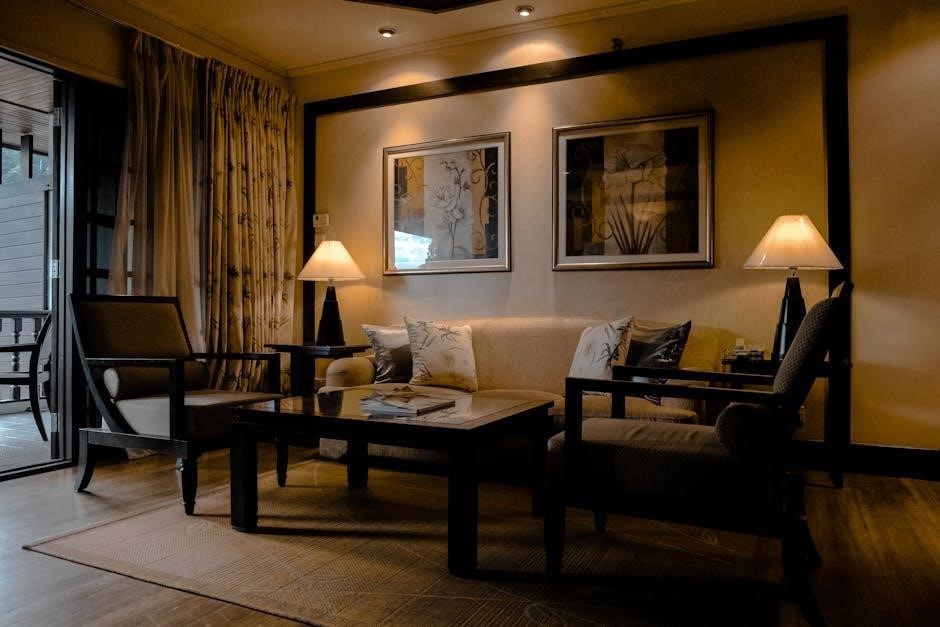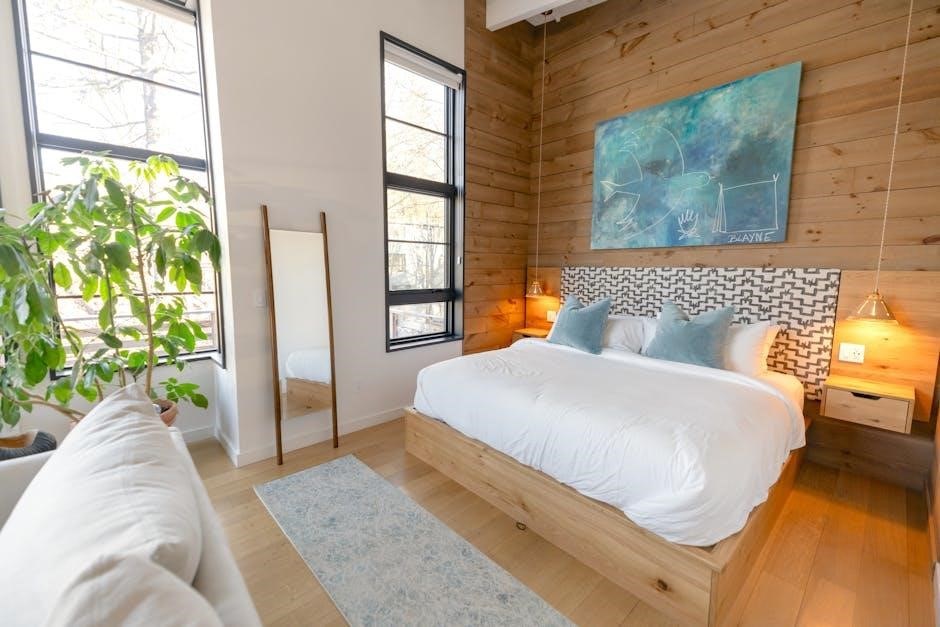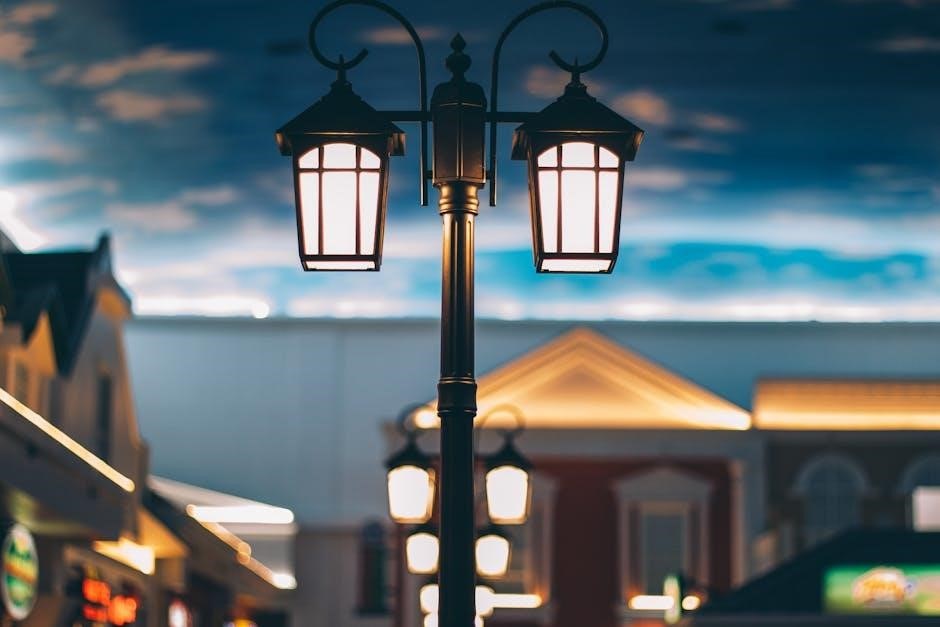Lava lamps are mesmerizing decorative pieces that combine colorful wax, water, and heat to create a hypnotic, flowing effect. They have become a cultural icon, blending art and science into a timeless visual experience.
1.1 What Are Lava Lamps?
Lava lamps are decorative devices that use a combination of water, oil, and wax to create a mesmerizing, flowing effect. The wax, denser than the surrounding liquid, melts when heated by a light bulb, rises as it expands, and cools to solidify again, repeating the cycle. This continuous motion creates a hypnotic display, making lava lamps both functional and visually appealing for home or office decor while providing a soothing ambiance.
1.2 The History of Lava Lamps
Lava lamps were first invented in 1963 by Edward Craven Walker, who was inspired by a homemade egg timer using water, oil, and wax. Walker refined the concept and popularized it, creating a cultural phenomenon in the 1960s. The lamps became symbols of the counterculture movement, embodying a groovy, psychedelic aesthetic. Over time, designs have evolved, but the core idea remains unchanged, blending art, science, and nostalgia into a timeless decorative piece that continues to captivate audiences today.
1.3 The Cultural Significance of Lava Lamps
Lava lamps symbolize the counterculture and psychedelia of the 1960s, becoming a staple in hippie and retro aesthetics. Their flowing, meditative motion inspired introspection and relaxation, making them a popular decorative item in homes and public spaces. Beyond their functional use, lava lamps represent a blend of art and science, transcending generations and cultural shifts. Their enduring popularity lies in their ability to evoke nostalgia and create a calming, immersive experience, making them a cherished part of modern decor as well.
The Science Behind Lava Lamps
Lava lamps operate through heat transfer, density differences, and buoyancy. The wax, denser than the surrounding liquid, melts and rises when heated, creating the iconic flowing effect.
2.1 The Physics of Lava Lamps
Lava lamps rely on heat transfer, buoyancy, and density differences. The wax, denser than the surrounding liquid, melts when heated, becoming less dense and rising. As it cools, it sinks, creating a continuous cycle. This process is driven by convection currents, where heat from the bulb warms the wax, causing expansion and reduced density. The lamp operates best in temperatures between 20-24°C, ensuring optimal wax melting and flow, making the physics both fascinating and visually captivating.
2.2 The Chemistry of Lava Lamps
Lava lamps operate through a combination of water, oil, wax, and heat. The wax, typically a paraffin-based compound, is denser than the surrounding liquid when cool. When heated, it melts, reduces in density, and rises. The colored water and oil mixture creates a vibrant visual effect. Additives like antifreeze lower the melting point of wax, while dyes enhance color. The chemical balance ensures the wax flows smoothly, creating the iconic lava-like motion when heated, making the chemistry both functional and aesthetically pleasing.
2.3 The Role of Heat in Lava Lamps
Heat is the driving force behind a lava lamp’s operation. It melts the wax, causing it to expand and rise through the colored liquid. The ideal operating temperature is between 20°C and 24°C (69°F to 75°F). If the lamp is too cool, the wax won’t melt properly. Overheating can damage the lamp, so it’s crucial to use the recommended bulb wattage. Heat creates the flowing, mesmerizing effect, making it essential for the lamp’s functionality and visual appeal.

How to Make a DIY Lava Lamp
Create a DIY lava lamp using oil, water, food coloring, and an effervescent tablet. Fill a bottle 1/4 with water, add oil, color, and tablet for a lava-like effect. Watch as the colorful mixture bubbles and flows, mimicking the iconic lava lamp motion. This fun, easy project brings the magic of lava lamps to your home with simple materials.
3.1 Materials Needed
To create a DIY lava lamp, you’ll need a clear plastic or glass bottle, water, vegetable oil, food coloring, effervescent tablets (like Alka-Seltzer), and a dropper. Add a heat source, such as a lamp, to melt the wax-like mixture. Ensure the bottle is clean and dry before starting. These simple materials will help you replicate the iconic lava lamp effect at home. Customize colors and ingredients for unique variations.
3.2 Step-by-Step Instructions
Fill the bottle 1/4 with water and add a few drops of food coloring. Pour vegetable oil until the bottle is almost full. Break an Alka-Seltzer tablet into small pieces and drop them in. Quickly attach the bottle to the lamp. Turn it on to heat the mixture. The oil and water will separate, creating a lava-like effect as the tablets react, producing bubbles. This simple process mimics the classic lava lamp, providing an engaging and colorful display for any room.
3.3 Tips for Customizing Your DIY Lava Lamp
Customize your lava lamp by experimenting with different oil colors, water densities, and wax textures. Use metallic powders or glitter for a shimmering effect. Try varying the shape and size of the container for unique visuals. Add small, lightweight objects like beads or sequins for extra movement. Adjust the heat source or lighting to alter the flow and color intensity. For a personalized touch, wrap the bottle with decorative fabric or paper. These tweaks can make your DIY lava lamp truly one-of-a-kind and visually striking.

Collecting and Maintaining Lava Lamps
Collecting and maintaining lava lamps requires care to preserve their unique visual appeal. Regularly check for air bubbles and ensure proper heat distribution. Clean gently to avoid damage, and store in a stable environment away from direct sunlight. Vintage models may need special handling, while modern designs offer easier upkeep. Proper maintenance ensures lasting enjoyment of their mesmerizing flow and colorful beauty.
4.1 Tips for Collecting Vintage Lava Lamps
When collecting vintage lava lamps, research their history and authenticity. Look for rare colors, unique designs, and original packaging. Inspect for damage or wear, and ensure the lamp functions properly. Vintage models from the 1960s and 1970s are highly sought after. Check for original bulbs and avoid overpolishing metal parts. Store them in a cool, dry place to preserve condition. Purchasing from reputable sellers ensures quality and value for these iconic, nostalgic pieces of decor.
4.2 How to Clean and Maintain Your Lava Lamp
Regularly clean your lava lamp with a soft cloth to remove dust and fingerprints. Avoid harsh chemicals, as they may damage the finish. Place the lamp on a level, stable surface away from drafts. Operate it in a room with a consistent temperature of 20-24°C (69-75°F) to ensure optimal performance. Never submerge the lamp in water or shake it vigorously. Store the lamp upright in a cool, dry place when not in use to preserve its condition and functionality.
4.3 Common Issues and Solutions
If the wax isn’t melting, ensure the lamp is on a level surface and the room temperature is between 20-24°C (69-75°F). Avoid placing it near drafts or fans. For air bubbles in the lava, allow the lamp to cool and restart it. If the lava stops flowing, check the bulb wattage and ensure it’s suitable. Replace the bulb if necessary. Always follow the manufacturer’s guidelines for bulb replacement and operating conditions to maintain optimal performance and extend the lamp’s lifespan.
The Art of Using Lava Lamps
Lava lamps enhance any space with their hypnotic flow and vibrant colors. Use them to create a relaxing ambiance or as a unique decorative centerpiece indoors.
5.1 Choosing the Right Bulb for Your Lava Lamp
Selecting the correct bulb is crucial for optimal performance. Use a 40-60W incandescent bulb to ensure proper heat for wax melting. Avoid LED bulbs, as they emit less heat. A halogen bulb is a good alternative, providing consistent warmth. Ensure the bulb fits securely to maintain even heat distribution. Replace bulbs carefully to avoid damaging the lamp. The right bulb ensures smooth lava flow and prevents overheating, enhancing your lava lamp’s visual appeal and longevity.
5.2 Optimizing the Performance of Your Lava Lamp
For optimal performance, allow your lava lamp to operate for 8-10 hours initially to ensure the wax fully softens. Place it on a level, stable surface away from drafts or direct sunlight. Maintain a room temperature between 20-24°C (69-75°F) for consistent flow. Avoid overheating by using the correct bulb size and wattage. Periodically rotate the lamp to distribute heat evenly. If air bubbles form, turn the lamp off and let it cool before restarting. Proper care enhances the visual experience and longevity of your lava lamp.
5.3 Using Lava Lamps for Decorative Purposes
Lava lamps are a vibrant addition to any room, offering a soothing, meditative ambiance. Their flowing, colorful patterns create a relaxing atmosphere, perfect for living spaces, bedrooms, or offices. Use them as a centerpiece or accent piece to enhance décor. The lamps’ futuristic design and mesmerizing visuals can guide users into a flow state, making them ideal for spaces meant to unwind. Their timeless appeal ensures they complement both retro and modern aesthetics, adding a touch of psychedelic charm to any setting.

Troubleshooting Common Problems
Common issues include wax not melting, air bubbles, or flow problems. Ensure the lamp is on a level surface, avoid drafts, and use the correct bulb for optimal performance.
6.1 Why the Wax Isn’t Melting
The wax in your lava lamp may not melt if the lamp isn’t heating properly. This can occur if the bulb is too low in wattage or the room temperature is too low. Ensure the lamp is placed on a level surface and away from drafts. Using a 60W bulb or higher can help, but avoid overheating. Allow the lamp time to warm up, as wax takes time to melt and flow. If issues persist, check for blockages or improper assembly.
6.2 Dealing with Air Bubbles in the Lava
Air bubbles in the lava are common, especially when the lamp is new or hasn’t been used for a while. They typically appear during the first few uses and clear up on their own. To address this, turn the lamp on and off to allow the wax to cool and reset. Running the lamp for several hours can also help bubbles dissipate. If persistent, ensure the lamp is on a level surface and in a room with a stable temperature (20-24°C or 69-75°F). Avoid shaking the lamp, as this can worsen the issue.
6.3 Fixing a Lava Lamp That Won’t Flow
If your lava lamp isn’t flowing, ensure it’s placed on a level surface and in a room with a stable temperature between 20-24°C (69-75°F). Check for drafts or fans, as they can disrupt heat distribution. Replace the bulb with a 60-watt equivalent to ensure adequate heat. Allow the lamp to run continuously for 8-10 hours to warm up properly; If the wax remains solid, it may need more time to melt. Avoid overheating, as this can damage the lamp or cause the wax to degrade. Patience is key, as some lamps require multiple cycles to function smoothly.

The Cultural Impact of Lava Lamps
Lava lamps symbolize the 1960s counterculture, representing psychedelia and nonconformity. They became iconic decor in modern pop culture, inspiring art and design while embodying a timeless, meditative appeal.
7.1 Lava Lamps in the 1960s Counterculture
Lava lamps became a defining symbol of the 1960s counterculture, embodying the era’s fascination with psychedelia and nonconformity. Their flowing, colorful patterns resonated with the movement’s emphasis on visual and sensory experiences. Often featured in hippie dens and psychedelic rooms, lava lamps were seen as tools for meditation and inspiration, reflecting the cultural shift toward experimentation and artistic expression during this transformative period in history.
7.2 Lava Lamps in Modern Pop Culture
Lava lamps continue to captivate modern audiences, appearing in films, TV shows, and music videos as retro symbols of creativity and relaxation. They are often featured in nostalgic settings, evoking memories of the past while inspiring new generations. Their hypnotic flow has also influenced digital art and design, with lava lamp-like visuals used in apps and animations. Today, lava lamps remain a popular decorative item, blending seamlessly into contemporary interiors while maintaining their iconic status as cultural treasures.
7.3 The Symbolism of Lava Lamps
Lava lamps symbolize tranquility, creativity, and the fluidity of life. Their flowing wax represents constant change and relaxation, making them a popular tool for meditation and stress relief. Often seen as retro icons, they evoke nostalgia for the 1960s counterculture movement, embodying free expression and psychedelia. Today, lava lamps are also used in sensory therapy, providing calming visual stimulation. Their enduring appeal lies in their ability to captivate and inspire, transcending generations as both decorative pieces and cultural symbols.
The Future of Lava Lamps
The future of lava lamps lies in sustainable designs, modern materials, and innovative technology, blending tradition with eco-friendly practices to captivate new generations while maintaining their timeless appeal.
8.1 Modern Designs and Innovations
Modern lava lamps are evolving with sleek, futuristic designs that blend seamlessly with contemporary home decor. Innovations include LED lighting for energy efficiency and app-controlled color changing. Some models feature unique shapes and customizable options, allowing users to personalize their lamps. Additionally, eco-friendly materials and sustainable manufacturing processes are being explored to reduce environmental impact while maintaining the iconic, mesmerizing effect of traditional lava lamps. These advancements ensure lava lamps remain relevant and captivating in the modern era.
8.2 The Role of Technology in Lava Lamps
Technology has revolutionized lava lamps, introducing LED bulbs for energy efficiency and digital thermostats for precise temperature control. Smart technology now allows users to adjust colors and patterns via apps. Innovations in materials science have improved wax formulations for smoother flow and vibrant colors. These advancements enhance performance while maintaining the timeless appeal of lava lamps, ensuring they remain a captivating blend of art and science in the modern world.
8.3 The Sustainability of Lava Lamps
Modern lava lamps prioritize sustainability through energy-efficient LED bulbs and eco-friendly materials. Many manufacturers now use recyclable components and biodegradable packaging. Some designs incorporate solar-powered options to reduce energy consumption. By adopting these practices, lava lamps align with environmental consciousness while maintaining their iconic visual appeal. This shift ensures they remain a beloved, eco-responsible home decor choice for future generations.

Safety Precautions
Always handle lava lamps with care to avoid breakage. Place them on a stable, heat-resistant surface away from flammable materials. Keep out of reach of children and pets.
9.1 Handling the Lava Lamp Safely
Always place your lava lamp on a stable, level surface away from drafts or flammable materials. Avoid touching the lamp when it’s in use, as it may become hot. Use the correct bulb size recommended by the manufacturer to prevent overheating. Never move or tilt the lamp while it’s operating, as this can cause the wax to adhere to the sides. Allow the lamp to cool completely before handling or storing it. This ensures safe operation and maintains its performance.
9.2 Avoiding Common Hazards
To prevent accidents, ensure your lava lamp is placed on a heat-resistant surface, away from children and pets. Never leave it unattended while in use. Avoid exposing the lamp to direct sunlight or moisture, as this can damage the electrical components. Keep the lamp away from flammable materials, such as curtains or bedding. Using the correct wattage bulb is crucial to prevent overheating, which can lead to fire hazards. Regularly inspect the cord and plug for any signs of wear or damage. Proper care ensures safe and enjoyable use of your lava lamp.
9.3 Storing Your Lava Lamp Properly
To store your lava lamp safely, place it on a stable, heat-resistant surface away from direct sunlight and moisture. Keep it upright to prevent the wax from sticking to the sides. Avoid storing it near flammable materials or heat sources. Clean the lamp with a soft cloth to remove dust before storage. Consider removing the bulb to prevent potential issues. Store it in a cool, dry place to maintain its condition and ensure longevity.
Lava lamps captivate with their unique blend of art, science, and nostalgia, offering a calming, timeless visual experience that continues to inspire and enchant across generations globally.
10.1 The Timeless Appeal of Lava Lamps
Lava lamps captivate audiences with their hypnotic, flowing motion, blending art and science into a soothing visual experience. Their timeless appeal lies in their ability to evoke nostalgia while offering a calming, meditative effect. Whether as a retro decoration or a modern design piece, lava lamps continue to charm with their unique combination of color, light, and fluid dynamics, making them a beloved and enduring element of home decor across generations.
10.2 Final Tips for Enjoying Your Lava Lamp
To fully enjoy your lava lamp, place it on a stable, level surface away from drafts. Use the recommended bulb size to avoid overheating. Allow the lamp time to warm up properly, as rushing the process can hinder performance. Experiment with different colors and layers for a unique visual experience. Always follow safety guidelines and clean the lamp gently to maintain its appearance. With patience and proper care, your lava lamp will provide hours of mesmerizing, meditative enjoyment.
